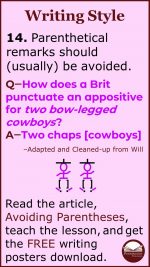Wordiness
“Mr. Parkins, I don’t understand your comment on my essay. It says, ‘Wordy.’”
“Wordiness means using too many words to say too little, Elton.”
“Mr. Parkins, you said our essay had to be 700 words. I’ve got 702. How can it be ‘wordy’ when it only has two extra?”
“Elton, this essay has more padding than my overstuffed pillows. You turned a 500-word essay into 702 words. Better to be too short than too long.”
Definition and Examples
Learning how to write concisely (briefly) and efficiently is important. When wording is added which does not contribute meaning, teachers call this padding. Padding includes needless or repetitive information included in order to fill up a page. When too many words are used to communicate that which could be said more concisely, teachers call this wordiness. Often, a wordy writer uses noun constructions, rather than simple verbs. Examples: Instead of for the production of, the writer might say produce.
Read the rule.
Avoid using useless noun phrases, especially ones which begin with prepositions. Instead, use specific nouns and verbs to write concisely (briefly).
Read the following sentences and [bracket] the wordiness.
- For the purposes of this writing, I will share these very interesting documents.
- The majority of most of my friends urged me not to speak at this point in time.
- I told them of each and every circumstance with the exception of five instances.
- During the course of the investigation, in an effort to tell the truth, he did an interview.
- The audience could not hear at all what the speaker said.
Revise the sentence to eliminate wordiness.
Cease, desist, and stop wordiness.
Answers
- For [the purposes of] this writing, I will share these [very interesting] documents.
- [The majority of] most of my friends urged me not to speak at this point [in time].
- I told them of [each and] every circumstance [with the] excep[tion of] five instances.
- During [the course of] the investigation, [in an effort to] tell the truth, he did an interview.
- The audience could not hear [at all] what the speaker said.
*****
For more essay rules and practice, check out the author’s TEACHING ESSAYS BUNDLE. This curriculum includes 42 essay strategy worksheets corresponding to teach the Common Core State Writing Standards, 8 on-demand writing fluencies, 8 writing process essays (4 argumentative and 4 informative/explanatory), 64 sentence revision and 64 rhetorical stance “openers,” writing posters, and helpful editing resources. Differentiate your essay instruction in this comprehensive writing curriculum with remedial writing worksheets, including sentence structure, grammar, thesis statements, errors in reasoning, and transitions.Plus, get an e-comment bank of 438 prescriptive writing responses with an link to insert into Microsoft Word® for easy e-grading (works great with Google Docs),
Download the following 24 FREE Writing Style Posters to help your students learn the essay rules. Each has a funny or ironic statement (akin to “Let’s eat Grandma) to teach the memorable rule.








